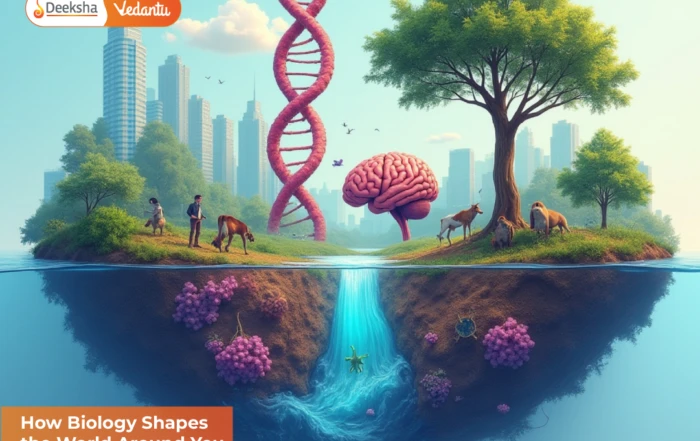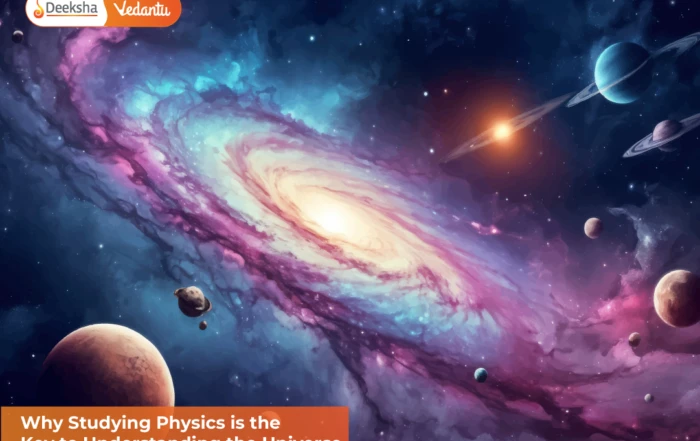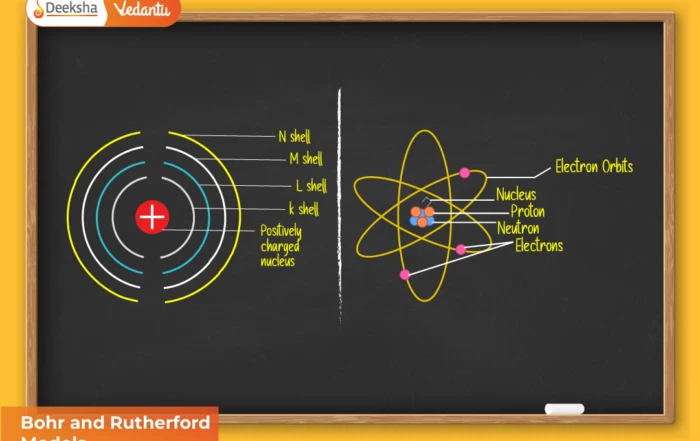Thermodynamics forms the foundation of physical chemistry by explaining how energy moves within and between systems. It deals with the study of energy transformations, particularly between heat and mechanical work. In this section, we will understand essential terms such as system, surroundings, types of systems, and important concepts like internal energy, state functions, and the First Law of Thermodynamics. These concepts are crucial for analyzing chemical reactions and predicting their direction and feasibility.
Energy changes occur in all chemical and physical processes — from melting ice to burning fuels. By mastering thermodynamic terms, students can interpret how and why these energy exchanges happen, which is key for exams like NEET and JEE.
System and Surroundings
In thermodynamics, any process we study is divided into two parts: the system and its surroundings.
- System: The specific portion of the universe chosen for study, such as the reactants in a chemical reaction or gas in a piston.
- Surroundings: Everything outside the system that interacts with it through energy or matter exchange.
The system and surroundings together constitute the universe. The boundary separating the system from the surroundings may be real (like the walls of a beaker) or imaginary, depending on the problem.
Examples:
- A cup of hot coffee represents the system; the surrounding air and table are the surroundings.
- A reaction taking place in a closed flask — the contents form the system, and the flask and external environment form the surroundings.
The boundary can be fixed (as in a closed vessel) or movable (as in a piston), affecting whether the system performs work on the surroundings.
Types of Systems
Thermodynamic systems are classified based on whether they exchange matter and energy with their surroundings.
| Type | Matter Exchange | Energy Exchange | Example |
| Open | Yes | Yes | Boiling water in an open pot |
| Closed | No | Yes | Gas in a sealed cylinder |
| Isolated | No | No | Hot water in a thermos flask |
Detailed Explanation
- Open System: Allows both energy and matter to move in or out. For example, during boiling, steam escapes and heat is exchanged with the air.
- Closed System: Only energy (like heat or work) is exchanged, not matter. For instance, a sealed gas cylinder allows heat transfer but no gas escape.
- Isolated System: Neither energy nor matter exchange occurs. A thermos bottle aims to maintain this condition to prevent heat loss.
These distinctions help predict the behavior of systems under different physical and chemical conditions.
State of a System
The state of a system describes its present condition and can be defined by measurable macroscopic properties such as:
- Pressure (P): Force exerted by gas molecules per unit area.
- Volume (V): Space occupied by the system.
- Temperature (T): Measure of average kinetic energy of particles.
- Composition: Nature and quantity of substances present.
A system’s state changes whenever any of these variables are altered. For instance, compressing a gas changes its pressure, volume, and temperature.
State Functions vs Path Functions
Understanding how properties depend on process or state is vital in thermodynamics.
- State Functions: Depend only on the initial and final states, not on the route taken. Examples include Internal Energy (U), Enthalpy (H), and Entropy (S).
- Path Functions: Depend on the specific path followed during a process. Examples include Heat (q) and Work (w).
Comparison Table
| Property Type | Depends On | Examples | Characteristic |
| State Function | Initial and Final States | U, H, S, P, T | Independent of path |
| Path Function | Process Path | q, w | Dependent on path |
Thus, if a system changes from one state to another, the total change in a state function remains constant, regardless of how the change occurs. However, the amount of work or heat transferred can differ based on the path taken.
Internal Energy (U)
The internal energy of a system is the total energy contained within due to molecular motion, vibration, rotation, and chemical bonding. It is an extensive property and depends on the amount of substance present.
Change in Internal Energy (ΔU)
When a system undergoes a transformation, its internal energy changes according to:
ΔU = q + w
where:
- q = heat absorbed by the system
- w = work done on the system
If the system performs work, energy leaves the system, making work negative. For expansion work:
w = -PΔV
Thus, the equation becomes:
ΔU = q – PΔV
This is the mathematical form of the First Law of Thermodynamics, which states:
Energy can neither be created nor destroyed; it can only be transformed from one form to another.
For instance, in a chemical reaction, the heat released is equal to the decrease in internal energy of the reactants.
Examples of Internal Energy Change
- Heating a Gas: q is positive (energy absorbed), ΔU increases.
- Cooling a Gas: q is negative (energy released), ΔU decreases.
- Expansion Work: The system does work on surroundings; internal energy decreases.
- Compression Work: Surroundings do work on system; internal energy increases.
Work and Heat
Both heat and work are fundamental modes of energy transfer between a system and surroundings.
- Work (w): Energy transfer resulting from a force acting through a distance. Example: expansion or compression of gases.
- Heat (q): Energy transfer due to a temperature difference between system and surroundings.
Key Points:
- Both q and w are path functions.
- Heat and work can change the internal energy but are not properties of the system.
- The direction of heat flow determines the sign convention:
- q > 0 → heat absorbed by the system
- q < 0 → heat released by the system
Example: Gas Expansion
Consider 1 mol of an ideal gas expanding against a constant external pressure of 1 atm from 2 L to 5 L.
w = -PΔV = -(1 atm)(5 – 2) L = -3 L·atm
Since 1 L·atm = 101.3 J,
w = -303.9 J
Here, the negative sign indicates that the gas (system) does work on the surroundings by expanding. The total internal energy change can be calculated if the heat exchanged (q) is known.
Additional Example:
If the same gas is compressed from 5 L to 2 L under the same pressure,
ΔV = -3 L → w = -PΔV = +(1 atm)(3 L) = +303.9 J
In this case, the surroundings perform work on the system, increasing its internal energy.
Practice Questions (NEET & JEE)
- Define system and surroundings with examples from daily life.
- Differentiate between open, closed, and isolated systems with one real-world example each.
- What are state and path functions? Give at least two examples of each.
- Derive the First Law of Thermodynamics using the relation between ΔU, q, and w.
- Explain how the internal energy changes during gas compression and expansion.
- Why are heat and work not state functions, even though internal energy is?
FAQs
Q1. What is the difference between system and surroundings?
A system is the specific part of the universe we study, like a chemical reaction, while surroundings include everything else interacting with it, such as the container or environment.
Q2. What are examples of state functions?
State functions include enthalpy (H), internal energy (U), entropy (S), temperature (T), and pressure (P), as they depend only on the current condition of the system.
Q3. Why is work considered a path function?
Work depends on the manner in which a process occurs (path), such as whether expansion happens reversibly or irreversibly, not just the initial and final states.
Q4. What does the First Law of Thermodynamics state?
It states that the total energy of the universe remains constant; energy can change from one form to another but cannot be created or destroyed.
Q5. What happens to internal energy when a gas expands?
When a gas expands, it performs work on the surroundings, and unless compensated by heat absorption, its internal energy decreases (ΔU < 0).
Q6. How is energy conserved during chemical reactions?
The heat released or absorbed during a chemical reaction equals the change in internal energy or enthalpy, ensuring the total energy remains constant.
Conclusion
The study of thermodynamic terms provides the groundwork for understanding energy flow in nature and chemical processes. Concepts like system, surroundings, and state functions enable us to predict the behavior of substances under different conditions. The First Law of Thermodynamics reinforces the conservation of energy principle, explaining how heat and work relate to internal energy. Mastering these basics is crucial for solving advanced problems in physical chemistry, NEET, and JEE.











Get Social